This is a struggle, above all, for the minds of men.
—President Harry Truman
Radio Free Europe and Radio Liberty fought communism by broadcasting news and features from Munich to countries behind the Iron Curtain. Despite jamming, acts of terrorism, and even opposition by some members of Congress, Radio Free Europe and Radio Liberty have remained on the air, broadcasting uncensored news since the early 1950s.
 |
| A 10-ton bell, symbol of Radio Free Europe, is lifted from the casting pit at the British foundry of Gillett and Johnston.
|
The Origin of the Radios
The radios came into being after World War II in response to the thousands of displaced persons throughout Western Europe, a large number of whom were housed in refugee camps in West Germany, while others had fled to Paris, London, New York, and Washington from Eastern Europe and the Soviet Union in advance of the Red Army or as the result of communist takeovers. Many had been incarcerated in POW camps and refused to be repatriated to lands controlled by the Soviets after the war ended.
As communist governments took over in Eastern Europe, the U.S. government realized that these émigrés represented a powerful force against their communist-controlled homelands and it recruited them as writers, speakers, and in other capacities to facilitate the return of democratic governments.
George Kennan of the State Department asked Ambassador Joseph C. Grew to enlist prestigious civilians to lead an anticommunist organization dedicated to returning democracy to Eastern Europe, using the talents of the refugees. This organization, the National Committee for a Free Europe (NCFE), later the Free Europe Committee, was established in 1949 with several objectives: find work for the democratic émigrés from Eastern Europe; put émigré voices on the air in their own languages; and carry émigré articles and statements back to their homelands through the printed word. These objectives were realized through the establishment of a publishing division, Free Europe Press, and a broadcast division, Radio Free Europe (RFE).
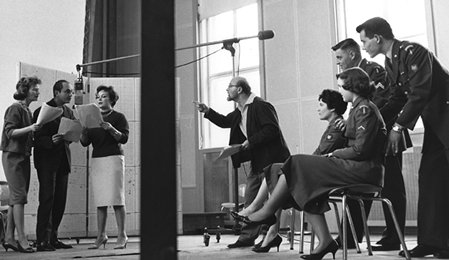 |
| Czech and Slovak broadcasters record a radio play in an RFE studio with assistance from U.S. army personnel.
|
The Crusade for Freedom
Funded primarily by Congress through the CIA until 1972, the NCFE maintained a public identity as a private corporation of freedom-loving American citizens. A separate organization, the Crusade for Freedom, was formed in 1950 to promote the NCFE and to raise money for its activities. President Dwight Eisenhower announced, in a nationwide radio address: "The Crusade for Freedom will provide for the expansion of Radio Free Europe into a network of stations. They will be given the simplest, clearest charter in the world: ‘Tell the truth.’"
The Crusade for Freedom took as its symbol a bell resembling the American liberty bell, designed by Walter Dorwin Teague of New York. It had a laurel wreath symbolizing peace encircling the top and a frieze of five figures representing the five races of humankind passing the torch of freedom. An inscription quoted Abraham Lincoln: That this world under God shall have a new birth of freedom.
The 10-ton bell arrived from the British foundry of Gillett and Johnston to a ticker tape parade in New York City. The bell then visited 21 American cities, and people in every state were encouraged to sign Freedom Scrolls and contribute money for RFE. More than 16 million Americans responded; contributions the first year were $1,317,000.
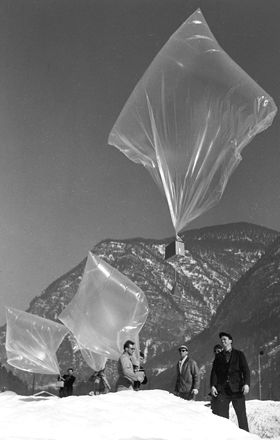 |
| Balloons carried boxes of leaflets whose text told the people that a new wind was blowing, a new hope was stirring. "Millions of free men and women have joined together and are sending you this message of friendship over the Winds of Freedom—which in the upper air always blow from West to East." On the leaflet’s reverse were listed the wavelengths of major free world stations transmitting to Czechoslovakia.
|
The bell then traveled to West Berlin, where it was permanently installed on United Nations Day, October 24, 1950. More than 400,000 Berliners—100,000 of them having risked crossing the border from East Berlin—filled City Hall Square to witness the dedication ceremonies. General Lucius Clay, chairman of the Crusade for Freedom, gave a speech, then pushed the button that started the bell ringing. Its deep tones were heard throughout East Berlin and into East Germany. The East German Communist Party denounced the Freedom Bell, with Politburo member Hans Jendretsky warning, "The rope of the death bell will become the gallows rope for those who ring it."
Although the Crusade for Freedom never raised enough money to fund more than a small part of the RFE budget, its ubiquitous advertising, along with parades, public forums, and slogans such as "Fight the Big Lie with the Big Truth" and "Help Truth Fight Communism," served to mobilize American support for the Cold War.
The Early Broadcasts
RFE initiated broadcasting when a 7.5-kilowatt shortwave transmitter, nicknamed Barbara and formerly used by the Office of Strategic Services during the war, was installed in West Germany at Lampertheim, near Frankfurt. On July 4, 1950, the first 30 minutes of news, information, and political analysis was sent to Czechoslovakia, to be followed later that year by programs to Romania, Hungary, Poland, and Bulgaria.
A larger transmission facility was completed the following year at Holzkirchen, near Munich, with the official inauguration on May 1 celebrating 11.5 hours of daily broadcasting to Czechoslovakia. This inaugural date was chosen because May 1—May Day—was a widely celebrated communist holiday honoring workers. According to C. D. Jackson, the president of the NCFE, "We thought that would be a good day to launch our station and to let some people know out loud, and quite loud, the difference between workers and slaves." Although the rhetoric moderated over the ensuing decades, the purpose of RFE and its sister station, Radio Liberty (RL), remained the same: to act as uncensored national media, offering an alternative to the highly censored Radio Warsaws and Radio Moscows of the communist world.
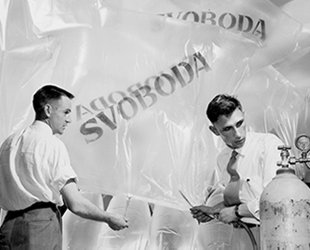 |
| Balloons being filled with hydrogen. Svoboda is Czech for "freedom."
|
RFE’s broadcasts were produced in New York, sent to Europe, and transmitted from Lampertheim and Holzkirchen in West Germany. A European production site, however, was essential if broadcasts were to be timely. West Germany, sharing a border with Czechoslovakia, had the best location and was still occupied by American forces; Munich, the second-largest city within the U.S. zone, was a center for East European émigrés, many of whom had experience in writing, editing, broadcasting, and the technical aspects of radio. In November 1952, at a site on the edge of Munich’s English Garden, RFE opened a complex with 22 studios, six control rooms (including master control, editorial, and technical spaces), and a maintenance service.
Balloon Warfare
While RFE programming was getting under way, the publishing arm of the NCFE was also busy. In 1951, Frank Wisner, the head of the Office of Policy Coordination, that section of the CIA responsible for RFE, inherited a stockpile of weather balloons left over from World War II. He immediately imagined a flotilla of balloons dropping millions of leaflets produced by the Free Europe Press, whose job it was to produce documents about Eastern European affairs.
A trial project took place over a two-week period in 1951. The prevailing west to east wind patterns carried the hydrogen-inflated balloons sailing over the border of Germany, where they dropped their payload of more than 11 million leaflets on Czechoslovakia.
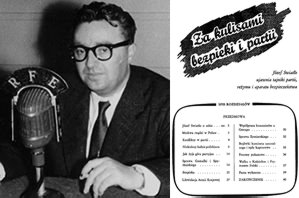 |
| Josef Swiatlo was the most highly ranked defector from Poland. A 40-page booklet of his testimony was printed, and thousands of copies were dropped on the Polish countryside from 10-foot balloons.
|
Following Stalin’s death in 1953, a series of demonstrations by factory workers in several eastern bloc countries encouraged the NCFE to try a coordinated four-day radio/balloon campaign called Operation Prospero. German civilian laborers readied 6,500 balloons and 12 million leaflets at launching sites near the Bavarian border village of Tirschenreuth. As leaflets fell, the Prague regime ordered jet fighter planes to shoot down the balloons (they hit only three). Meanwhile the leaflets dropped on isolated villages, where radios were rarities, as well as population centers.
In 1954, RFE, calling itself the "voice of the opposition," urged regime leaders to give Czech and Slovak citizens a way to veto that year’s election. Operation Veto developed a platform and 10 limited demands, all possible within the constraints of a communist state. Gummed stickers with the number 10 were dropped by balloons, turning up on government walls, telephone booths, and the doors of police buildings. When voting took place, at least 5 percent voted against the single slate of candidates by putting the number 10 on their ballot.
A Hungarian version of Operation Veto, named Operation Focus, was carried out in 1956; it was the last balloon project. A total of more than 300 million leaflets had gone over the Iron Curtain.
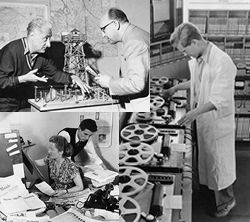 |
| Collecting the news.
|
Broadcasting to the Soviet Union
As RFE developed a growing listener base in Czechoslovakia, Poland, Hungary, Bulgaria, and Romania, the CIA became interested in broadcasting to the Soviet Union. A new organization, the American Committee for the Liberation of the Peoples of Russia (Amcomlib), created Radio Liberation, later renamed Radio Liberty; on March 1, 1953, it initiated service by broadcasting 67 hours a week. It was no sooner on the air than it was presented with one of the biggest news stories of the decade—the death of Stalin—on March 5. In contrast to RFE, RL maintained a low profile without the fanfare, promotion, and fund-raising with celebrity chairmen. This is why many Americans today have never heard of Radio Liberty.
One important programming resource, particularly for Radio Liberty, was samizdat, self-published literature considered seditious by the Soviet government and other communist regimes. Although those regimes tried to suppress dissident writing, frequently imprisoning the writers, they could not stop this literature being smuggled to the West. The writings of Boris Pasternak, Joseph Brodsky, Alexander Solzhenitsyn, Milovan Djilas, Andrei Siniavskii, Andrei Sakharov, and others were read on the radio. In addition, Radio Liberty officially collected and processed samizdat, creating the Samizdat Archive in Munich.
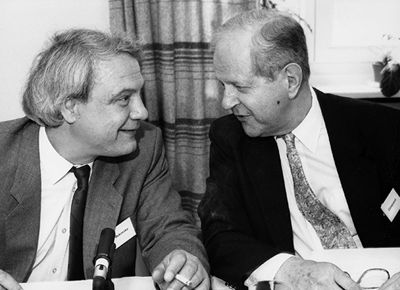 |
| RFE/RL hosted many forums on world issues at their Munich headquarters. Panel members Vladimir Bukovsky, Soviet dissident, scientist, and writer; and Robert Conquest, author, diplomat, and senior research fellow and Russian curator at the Hoover Institution, engage in a panel discussion on the implications of Mikhail Gorbachev’s glasnost policies, May 19, 1987.
|
The RFE Polish Service serialized the text of Solzhenitsyn’s three-volume Gulag Archipelago and presented it in its entirety on the radio in 15-minute segments. In a letter to Solzhenitsyn, Director Zygmunt Michalowski said, "It was our intention to reveal to the Polish people the communion of suffering which all the peoples subjected to communist rule have been sharing in varying degrees."
In addition to RFE and RL, the American government continued to support the Voice of America (VOA), a station that had begun broadcasting during World War II. VOA was quite different from RFE and RL, as it was clearly the voice of the United States, presenting the American point of view. More than half of VOA’s "talk" material was devoted to the internal scene in the United States, whereas RFE and RL emphasized the internal matters in their target countries and other communist states. Each RFE/RL service worked to be seen as a surrogate free press of its home country.
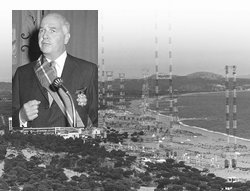 |
| Howland Sargeant, president of Amcomlib from 1954 to 1975, was decorated by the Spanish government with the Civil Order of Merit.
|
The Communist Response
The communist governments responded to the unwelcome radios by jamming their signals—broadcasting shrieks, howls, white noise, or other electronic sounds on the same frequencies—so that it was difficult or impossible to hear the program from RFE or RL. Jamming was done by the Soviet Union continually from within the first 10 minutes of programming in 1953 through most of 1988. The five RFE target countries all jammed at various times during the Cold War. In addition, the communist governments, viewing the émigré employees as traitors to their homelands, threatened employees and their families still living behind the Iron Curtain and carried out assassinations and bombings. Spies infiltrated the radios, some occupying key positions.
In September 1954, the body of Leonid Karas, a Belorussian desk writer, was found in the Isar River near Munich under suspicious circumstances. Two months later the chief of the RL Azerbaijani desk, Abdulrachmann Fatalibey, was murdered. The most notorious assassination was that of Georgi Markov, a Bulgarian writer and former associate of Bulgarian president Todor Zhivkov. He was stabbed with an umbrella containing a pellet of lethal ricin poison.
In 1959 atropin, a derivative of deadly nightshade, was put in the saltshakers of the RFE cafeteria by a Czech diplomat posted to Austria. The plot was revealed by a double agent who pretended to cooperate with the Communists while keeping RFE informed of their intentions.
A workman in coveralls approached the guard at one of the RFE balloon launch sites claiming that he was from the firm that supplied the hydrogen. He said he was to inspect the tanks, as some were thought to have leaks. A quick call summoned the Grenzpolizei (West German border police), who discovered that the man was carrying, in addition to his tools, several thermite (a mixture of aluminum powder and iron oxide that creates high heat when ignited) grenades and timers.
On February 21, 1981, a tremendous explosion rocked the RFE/RL headquarters in Munich, causing $2 million in damage and some injuries but no deaths. The Polish service was on the air with news of the event within 10 minutes. Stasi (East German secret police) files opened after 1989 indicated that the bombing was carried out by a group of international terrorists under the direction of Ilich Ramirez Sanchez, better known as Carlos the Jackal. Funding was provided by Nicolae Ceausescu, president of Romania. In the end, the impact of the threats, violence, spies, and bombing was negligible. RFE and RL continued their broadcasts without interruption throughout the communist period and up to the present day.
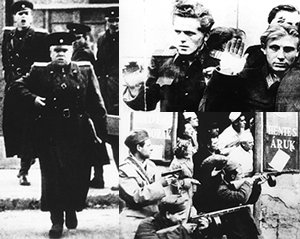 |
| The Hungarian Revolution, 1956.
|
The Year of Revolution
A challenge for RFE and RL managers was to prevent the often very nationalistic émigré announcers from straying from the path of professional journalism into political oratory. The events of 1956 illustrated the problem.
That year was pivotal for the entire communist bloc, beginning with Nikita Krushchev’s speech to the Twentieth Congress of the Communist Party of the Soviet Union detailing Stalin’s crimes. In the satellite countries, particularly Poland and Hungary, the speech appeared to predict a more liberal climate at home as well as a greater degree of freedom from Moscow. This was first put to the test in June when factory workers at the ZISPO works in Poznan, Poland, protesting changes in quotas, erupted in a violent demonstration. Although local troops refused to fire on the workers, order was restored when troops were dispatched from Warsaw.
Throughout the disorder, the head of RFE’s Polish desk, Jan Nowak, urged restraint and prudence, keeping the broadcasts in line with RFE’s policy of liberalization over liberation. The Hungarian desk, however, had no Jan Nowak to urge restraint. Bill Griffith, chief policy adviser in Munich, cautioned émigré broadcasters against overpraising reform leaders lest RFE provide ammunition to hard-liners preparing to counterattack. This was followed by a memo counteracting the former policy, demanding an all-out propaganda offensive from newly appointed RFE director W. J. Convery Egan in New York.
The ensuing Hungarian Revolution resulted in some 10,000–20,000 deaths. In some quarters, RFE’s Hungarian broadcasting was held responsible for encouraging Hungarian resistance, and investigations were initiated by the United Nations, the West German government, a U.S. congressional subcommittee, and the Council of Europe. Although RFE was cleared of provoking the uprising, it was criticized for giving the impression that Western aid was forthcoming. In addition, the West German report also mentioned RFE’s tone, irresponsible statements, gratuitous advice, and errors in political judgment.
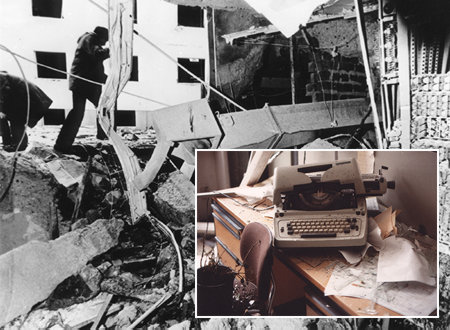 |
| The bombed headquarters of RFE/RL, Munich, February 21, 1981.
|
The World Changes, the Radios Change
RFE emerged from the events and criticisms of 1956 a more professional news-gathering, analyzing, and broadcasting service. News broadcasts focused on hard news with commentaries and features identified as such, and morale was high.
The peace of the period was broken with the March 1967 issue of Ramparts, one of the leading magazines of the 1960s counterculture. A disgruntled student member of the National Students Association (NSA) and Students for a Democratic Society, learning that one of NSA’s major funders was the CIA, took the information to the magazine. Although the radios were not mentioned in the Ramparts story, the piece did inspire numerous press investigations into covert CIA funding. A series of articles in the New York Times disclosed RFE’s links to the CIA, followed by a CBS documentary.
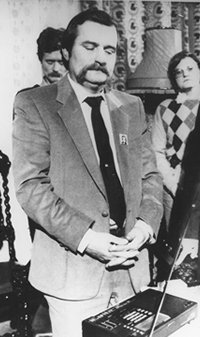 |
Lech Walesa, former president of Poland. Unable to leave Poland as there was no guarantee that he could return, Walesa listens to the RFE broadcast from Oslo, where he has just been awarded the 1983 Nobel Peace Prize for his advocacy of human rights and his organization of Solidarity. "Without Western broadcasting, totalitarian regimes would have survived much longer," Walesa would later write. "The struggle for freedom would have been more arduous and the road to democracy much longer. . . . From these broadcasting stations we gleaned our lessons of independent thinking and solidarity action." |
|
|
|
President Johnson called for a review of all CIA-funded anticommunist programs in organizations such as labor unions, publishing houses, and radio and TV stations. The reviewers concluded that no federal agency could provide covert financial help to any educational or voluntary organizations, but Richard Helms, director of the CIA, was able to exclude the radios as they were government initiatives and functioned under official government policy. This decision went unchallenged until 1971.
By the early 1970s détente had become the policy of the day. Among congressional supporters, the radios were viewed as essential in an era of negotiation. Among detractors, chief among whom was Senator J. William Fulbright, head of the Senate Foreign Relations Committee, the radios were viewed as relics of a Cold War past. Despite Fulbright’s vociferous objections, the Senate approved Public Law 93-129 by a vote of 76 to 10; the Board for International Broadcasting (BIB) Act became law on October 19, 1973. The BIB would receive the radios’ congressional appropriation and see that it was efficiently managed and that the program output was not inconsistent with broad U.S. foreign policy. The two radios became one corporation, RFE/RL, Inc., in 1976 and for a while maintained a corporate board. In 1982, this board was dissolved and BIB took complete control.
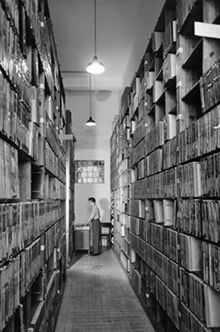 |
| The tape library in Lisbon, Portugal, former home to some of the more than 60,000 reels of broadcast tapes that will be arriving in the Hoover Institution Archives.
|
Under this structure, RFE/RL operated through the tumultuous times that marked the return to democracy in Eastern Europe and the end of the Soviet Union. With the fall of the Berlin Wall and the dissolution of the Soviet Union, many suggested that the radios’ mission had been successfully completed and that funding should be stopped. Others claimed that a responsible voice broadcasting to countries in which the institutions of democracy were still in their infancy required the continuation of the radios. Supporters included the heads of state of the countries to which RFE/RL broadcast. In 1993 the administration decided the radios were to be saved but reorganized. The budget was slashed.
Václav Havel, who appreciated the role of RFE as well as the ironies of history, invited the radios to relocate to Prague in the building of the former communist parliament, rent free, from where they currently broadcast. Corporate headquarters remain in Washington, D.C.
In 2000, an agreement was signed to deposit all the corporate and broadcast records up to 1995 in the Hoover Institution Archives. This immense resource of documents and broadcast tapes, when processed, will provide scholars with a record of every major event, movement, and personality in the former Soviet Union and Eastern Europe throughout the Cold War and during the early years of transition to democracy.







